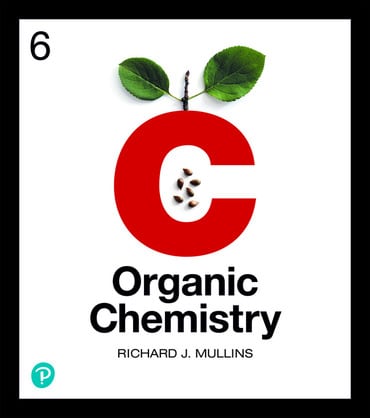
Organic Chemistry: A Learner Centered Approach, 1st edition
Title overview
For courses in organic chemistry (2-semester).
Built for the way students learn organic chemistry
Organic Chemistry: A Learner-Centered Approach teaches students how to learn organic chemistry. Rick Mullins' friendly, conversational style establishes a rapport with students, using authority and humor. He draws on modern learning science to move students away from memorization, leading them to become better problem solvers who understand the principles linking concepts.
The narrative builds a dialog, coaching students through mechanisms and chemical reactivity. This approach equips students to succeed in organic chemistry by understanding the chemical logic behind the problem-solving process.
Hallmark features of this title
- Thinking Like a Chemist provides practice in analytical thinking to help students approach topics the way a scientist might.
- Coaching tips speak to students, pose questions, suggest ways to process difficult material and direct them to resources.
- Solved-Assessment Videos are visually engaging videos integrated throughout the narrative and feature the author and his colleagues working through problems, encouraging students to check their understanding of key concepts and reaction mechanisms.
- The innovative art program, informed by Chemical Education Research, provides a visual learning experience, combats memorization and promotes understanding through clear annotations, connections between prior and future learning, and use of reaction coordinate diagrams.
Additional features of this title
- Bouncing Arrows, supported by Chem Ed research, are blended into the art program as a learning tool and include traditional curved arrow notation to enhance understanding of electron flow by telling a visual story.
- Chemistry in Context boxes help students make direct connections to real-world applications in the areas of biology, pharmacy, medicine and biochemistry.
- Green Chemistry coverage throughout the narrative shows a more sustainable and environmentally responsible way to do chemistry.
- NMR/IR Spectroscopy Simulations allow professors and students access to limitless spectral analysis with guided activities that can be used in the lab, in the classroom or after class to study and explore spectra virtually.
Key features
Highlights of the DIGITAL UPDATE for Mastering Chemistry (available for Fall 2026 classes)
Instructors, contact your sales rep to ensure you have the most recent version of the course.
- Approximately 127 new videos are available in the Study Area and Item Library, created by the author and a contributor.
- New Student Workbook is available for download in the Instructor Area and Study Area.
Features of Mastering Chemistry for the 1st Edition (published 2021)
- The Item Library is curated, classified, and organized into 4 tiers to help instructors to navigate Mastering Chemistry resources.
- Dynamic Study Modules focus on general chemistry remediation, acid-base chemistry, functional groups, nomenclature and key mechanisms.
Table of contents
- Introduction to Organic Chemistry
- General Chemistry Translated. Finding the Electrons
- Alkanes and Cycloalkanes. Properties and Conformational Analysis
- Acids and Bases/Electron Flow
- Chemical Reaction Analysis. Thermodynamics and Kinetics
- Stereoisomerism. Arrangement of Atoms in Space
- Principles of Green (Organic) Chemistry
- Alkenes 1: Properties and Electrophilic Additions
- Alkenes 2: Oxidation and Reduction
- Alkynes: Electrophilic Addition and Redox Reactions
- Properties and Synthesis of Alkyl Halides. Radical Reactions
- Substitution and Elimination. Reaction of Haloalkanes
- Alcohols, Ethers and Related Compounds. Substitution and Elimination
- Structural Identification 1: Infrared Spectroscopy and Mass Spectrometry
- Structural Identification 2: Nuclear Magnetic Resonance Spectroscopy
- Metals in Organic Chemistry
- Carbonyl Addition Reactions. Aldehydes and Ketones
- Nucleophilic Acyl Substitution 1: Carboxylic Acids
- Carboxylic Acid Derivatives. Nucleophilic Acyl Substitution 2
- Enolates/Carbonyl Addition and Substitution
- Conjugated Systems 1: Stability and Addition Reactions
- Conjugated Systems 2: Pericyclic Reactions
- Benzene 1: Aromatic Stability and Substitution Reactions
- Benzene 2.: Aromatic Stability and Substitution Reactions
- Amines. Structure, Reactions, and Synthesis
- Amino Acids, Proteins, and Peptide Synthesis
- Carbohydrates, Nucleic Acids, and Lipids
- Synthetic Polymers
Author bios
About our author
Richard J. Mullins, born near Detroit, Michigan, grew up in Middle Tennessee where his love of sports and science was cultivated. He attended Centre College, where he pitched for the college baseball team. Though he entered college intending to pursue a career in medicine, an inspiring organic chemistry professor changed his path, leading him to graduate in 1998 with a B.S. in Chemistry and plans for a career as an organic chemist. Upon enrolling at Indiana University, he considered multiple careers in chemistry before soon realizing that teaching at an undergraduate institution was his calling. After earning his Ph.D. from Indiana University in 2004, specializing in organic chemistry, Rick was hired as a tenure track professor at Xavier University.
He has taught at Xavier University ever since, being recently promoted in 2017 to Professor. His teaching has been recognized with multiple awards, including the Joan G. McDonald Teaching Award which recognizes excellent teaching in the sciences as well as the Alpha Sigma Nu Bishop Fenwick Teacher of the Year Award, the most prestigious teaching award given at Xavier University. His research has traditionally been focused on the development and application of new methods for the synthesis of small natural products with potential medicinal applications. Rick lives in Cincinnati, OH with his wife, Mary, daughter, Maggie, and son, John. When not teaching or writing about organic chemistry, Rick still enjoys participating in sports by coaching his son's select baseball team, running marathons and half-marathons, and supporting his favorite college and professional sports teams. Though records can't confirm it, because of his longevity in the sport, Rick is the [self-proclaimed] all-time leading scorer in intramural basketball history at Xavier University.